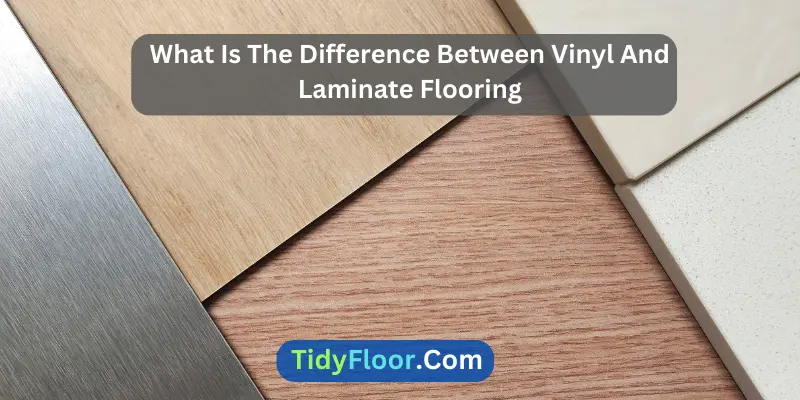In the realm of interior design and home improvement, vinyl and laminate flooring have emerged as two popular contenders, each boasting unique features and benefits. However, to finalize one flooring option between these two, you need to know what is the difference between vinyl and laminate flooring.
Vinyl and laminate flooring differ in material composition, with vinyl offering moisture resistance and style variety, while laminate is budget-friendly and easy to install. The choice depends on individual preferences and space requirements.
In this article, we will delve into the nuances that set laminate flooring and vinyl apart, highlighting their characteristics, installation processes, and suitability for various environments.
How to Tell the Difference Between Vinyl and Laminate Flooring: Key Differences
When faced with the choice between vinyl and laminate flooring, discerning their differences is crucial to making an informed decision for your home. The disparities between these two materials extend beyond mere appearances, encompassing composition, characteristics, installation methods, and overall suitability.
Composition:
Vinyl flooring is constructed from synthetic materials, primarily PVC (polyvinyl chloride), making it highly resistant to moisture and spills. On the other hand, laminate flooring is composed of multiple layers, including a fiberboard core and a photographic layer that mimics the appearance of real wood or stone.
Characteristics:
Vinyl flooring boasts remarkable water resistance, rendering it suitable for moisture-prone areas such as kitchens and bathrooms. Its versatility is reflected in a wide array of styles and patterns, including options that mimic hardwood, tile, and even natural stone. Laminate flooring, while not as impervious to moisture as vinyl, still offers moderate resistance. It excels in durability against scratches and wear, making it a suitable choice for spaces with high foot traffic.
Installation:
Vinyl flooring is often available in sheet, tile, or plank forms, each with its own installation method. Sheet vinyl is seamless and ideal for larger spaces, while vinyl tiles and planks are more DIY-friendly, allowing for creative patterns. Laminate flooring typically utilizes a click-and-lock installation system, making it relatively straightforward for homeowners to install themselves.
Suitability:
The choice between vinyl and laminate largely depends on the intended environment. Vinyl’s resilience to moisture and spills makes it an optimal choice for bathrooms, kitchens, and basements. Laminate, with its durability and scratch resistance, is well-suited for living rooms, bedrooms, and other moderate-traffic areas.
How to Transition Between Laminate and Vinyl Plank Flooring
Creating a seamless and visually appealing transition between laminate and vinyl plank flooring is essential for maintaining the overall aesthetics of your space. Whether you’re dealing with different flooring types in adjoining rooms or transitioning from one material to another within a single area, proper execution ensures a polished and professional finish.
Evaluate Height Differences:
Before embarking on the transition process, assess whether there are any height disparities between the laminate and vinyl plank flooring. If one material is thicker than the other, you’ll need to address this difference to achieve a smooth transition.
Choose the Right Transition Piece:
Selecting the appropriate transition piece is crucial for achieving a harmonious flow between the two flooring materials. Transition strips come in various styles, such as T-moldings, reducers, and threshold strips. T-moldings work well for rooms with equal-height flooring, while reducers are suitable for situations where the vinyl plank flooring is higher than the laminate. Threshold strips are ideal for doorways and areas where the flooring changes.
Prepare the Area:
Ensure that the area where the transition will take place is clean and free from debris. Remove any existing molding or baseboards that might obstruct the installation process.
Cut and Install Transition Strip:
Measure the width of the doorway or transition area and cut the transition strip to the appropriate length. If needed, use a saw or laminate and vinyl floor cutter to trim the strip for a precise fit. Install the strip by securing it to the floor using adhesive or nails, following the manufacturer’s instructions.
Secure and Conceal:
Ensure that the transition strip is securely in place, offering a stable bridge between the laminate and vinyl plank flooring. Some transition strips are designed to conceal the edges of both flooring types, creating a neat and seamless appearance.
Finishing Touches:
After the transition strip is in place, make any necessary adjustments to ensure a snug fit. If required, reinstall or replace baseboards or molding to complete the transition with a polished look.
Maintenance Considerations:
Regular cleaning with an appropriate laminate and vinyl floor cleaner and maintenance are essential to preserve the appearance and functionality of the transition area. Avoid using abrasive cleaners or tools that could damage the transition strip or the adjacent flooring.
FAQs
Is There A Difference Between Laminate And Vinyl Flooring?
Yes, there are distinct differences between laminate and vinyl flooring. Laminate flooring is composed of layers of fiberboard with a photographic layer mimicking wood or stone, offering durability against wear and scratches.
Vinyl flooring, made from PVC, is highly resistant to moisture and spills, making it suitable for wet areas. Vinyl comes in various styles, including wood and tile appearances. Both types offer unique advantages, and the choice depends on factors like moisture levels, traffic, and aesthetic preferences.
What Is The Difference Between Laminate Vinyl And Engineered Hardwood Flooring?
The key differences among laminate, vinyl, and engineered hardwood flooring lie in their composition and characteristics. Laminate features a fiberboard core with a photographic layer, providing affordability and scratch resistance.
Vinyl, made of PVC, excels in moisture resistance and style diversity. Engineered hardwood consists of real wood veneer over plywood, offering an authentic appearance and enhanced durability.
What’s The Difference Between Vinyl Laminate And Regular Laminate Flooring?
Vinyl laminate is crafted from PVC, offering remarkable moisture resistance and diverse style options. Regular laminate consists of fiberboard with a photographic layer, excelling in affordability and scratch resistance.
Both types are easy to install with different click-and-lock systems. The choice depends on preferences and requirements, with vinyl laminate suited for wet areas and regular laminate providing a cost-effective choice for spaces with moderate foot traffic.
Is Vinyl Flooring And Laminate Flooring The Same?
No, vinyl flooring and laminate flooring are not the same. Vinyl flooring is made from PVC, offering water resistance and diverse style options, including wood and tile looks. Laminate flooring consists of fiberboard with a photographic layer, known for affordability and scratch resistance.
While both are available in various installation methods, their distinct compositions and properties make them separate options. The choice between them depends on factors like moisture levels, durability needs, and desired aesthetics.
Conclusion:
Acknowledging what is the difference between vinyl and laminate flooring can help you choose the right option as per your preferences and specific needs. Now that you have the guide above, it’s time to decide.
So, whether you opt for the resilient versatility of vinyl or the budget-friendly charm of laminate, the beauty lies in finding the ideal match for your unique expression of style and functionality.


